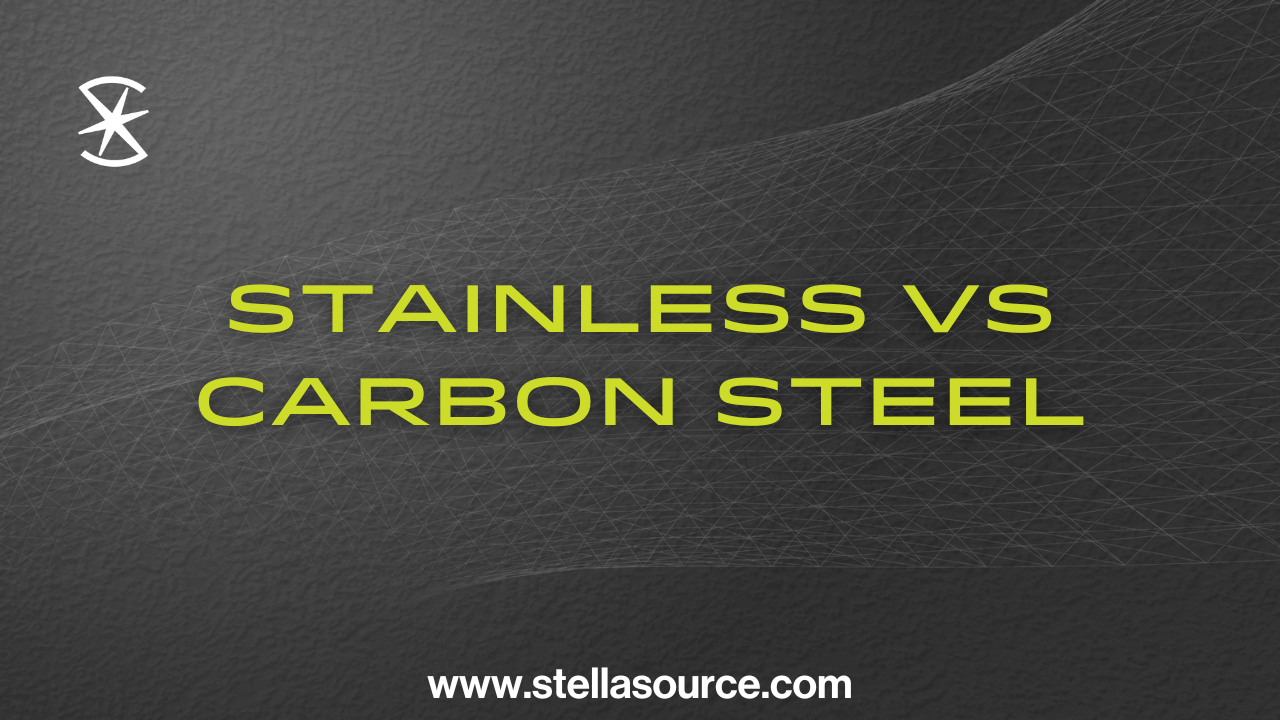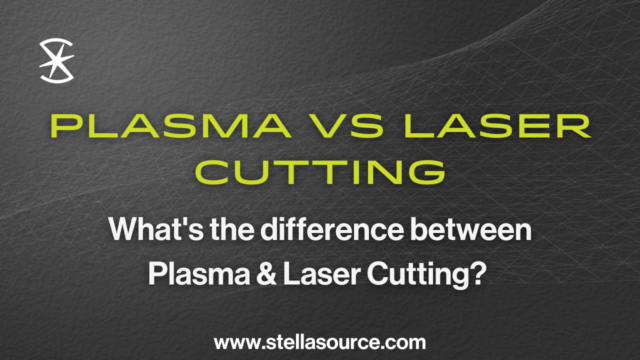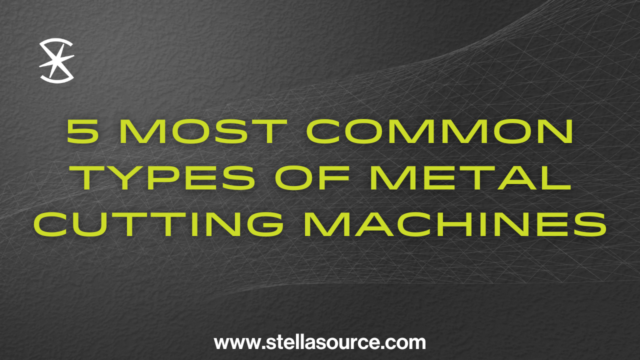When it comes to selecting the right material for various applications, steel often stands out as a top choice due to its exceptional strength, durability, and versatility. However, not all steel is created equal. In this article, we will explore the key differences between stainless steel and carbon steel, two widely used variations of this alloy. Understanding their contrasting characteristics will empower you to make informed decisions for your specific needs.
First, let’s discuss what stainless steel and carbon steel are and the typical types of each material. After gaining insight, a discussion of the differences and when each type of steel is used will give you an understanding of the alloy.
What is Stainless Steel?
Stainless steel is a widely used material known for its corrosion resistance, durability, and aesthetic appeal. It is primarily composed of iron. The addition of chromium, typically 11%, gives it corrosion-resistant properties. Stainless steel also contains varying amounts of other elements such as nickel, molybdenum, and manganese. Stainless steel can be found in cookware, appliances, automobiles and industrial equipment. It can also be rolled into sheets, plates, bars, wire and tubing.
Five types of stainless steel and their common uses:
Austenitic Stainless Steel:
Austenitic stainless steel is the most common type, representing approximately 70% of stainless steel production. It is characterized by its high levels of chromium and nickel, which make it highly corrosion-resistant and non-magnetic. Austenitic stainless steel is known for its excellent formability, weldability, and ductility, making it suitable for a wide range of applications such as kitchenware, food processing equipment, and architectural structures.
Ferritic Stainless Steel:
Ferritic stainless steel has a higher chromium content than other types, typically between 11% and 30%. It contains little to no nickel, which makes it less expensive than austenitic stainless steel. Ferritic stainless steel exhibits good corrosion resistance, high heat resistance, and magnetic properties. It is commonly used in automotive parts, heat exchangers, and appliances such as washing machines and dishwashers.
Martensitic Stainless Steel:
Martensitic stainless steel has a higher carbon content compared to other types, which gives it increased strength and hardness. It is heat treatable, allowing it to achieve even greater hardness. Martensitic stainless steel is magnetic and offers good corrosion resistance. It is frequently used in cutlery, surgical instruments, and turbine blades.
Duplex Stainless Steel:
Duplex stainless steel combines the properties of austenitic and ferritic stainless steels. It has a balanced microstructure, consisting of both austenite and ferrite phases, which results in improved strength and corrosion resistance. Duplex stainless steel offers high resistance to stress corrosion cracking and is commonly used in chemical processing equipment, offshore oil and gas applications, and desalination plants.
Precipitation-Hardening Stainless Steel:
Precipitation-hardening stainless steel, also known as PH stainless steel, is characterized by its ability to become stronger through heat treatment. It contains alloying elements such as chromium, nickel, and copper, which form precipitates during heat treatment, resulting in increased hardness. Precipitation-hardening stainless steel offers a unique combination of high strength, corrosion resistance, and toughness. It is commonly used in aerospace components, nuclear reactors, and high-performance applications.
What is Carbon Steel?
Carbon steel is a steel with a carbon content from about .05 to 2.1 percent by weight. It is also used to notate steel which is not stainless. Typically, carbon steel is divided into two main categories: low-carbon steel and high-carbon steel. This type of steel is used in construction and infrastructure projects as it is known for its strength. It is also a popular choice for knife-making because it gives the blade more edge retention.
High-carbon Steel
There is limited use of high carbon steel because of its higher cost of production, along with its poor ductility and weldability. It is mainly used in the farm industry and in the production of high-strength wires.
Low-carbon Steel
This is the most common type of steel because of its low price point and its properties. Low-carbon steel is malleable and ductile. And its surface harness can be increased with carburization. Typical usage is in car parts, pipes and construction.
5 differences between Stainless and Carbon Steel
Each type of steel has its own specific properties, making them suitable for different applications based on factors such as corrosion resistance, strength, formability, and cost. Understanding these differences allows for the selection of the most appropriate steel grade (stainless or carbon) for a particular purpose. Following are five differences between stainless and carbon steel.
Composition and Corrosion Resistance:
The primary distinction between stainless steel and carbon steel lies in their composition. Stainless steel is an alloy comprising iron, chromium, and other elements such as nickel and molybdenum, which provide excellent corrosion resistance. On the other hand, carbon steel contains iron and a higher carbon content, making it more vulnerable to rust and corrosion. Stainless steel’s chromium content creates a protective oxide layer on its surface, shielding it from environmental factors and making it suitable for applications in corrosive environments such as marine or chemical industries.
Strength and Durability:
Carbon steel exhibits impressive strength and hardness due to its higher carbon content, making it ideal for applications that require robustness and resistance to wear and tear. It is commonly used in construction, automotive, and heavy machinery industries. Stainless steel, while not as strong as carbon steel, still offers substantial strength and durability, especially in its various grades. Stainless steel’s resistance to corrosion and staining enhances its longevity, making it an excellent choice for products exposed to moisture, chemicals, or harsh weather conditions.
Magnetic Properties:
Another significant difference between stainless steel and carbon steel lies in their magnetic properties. Carbon steel is ferromagnetic, meaning it can be magnetized, while stainless steel, in its most common form (austenitic stainless steel), is non-magnetic. This magnetic property variation is useful in various applications, such as identifying different materials, separating metals, or preventing electromagnetic interference. If magnetic properties are a requirement, carbon steel would be the preferred choice.
Appearance and Aesthetics:
Stainless steel’s aesthetic appeal is often sought after in architectural, interior design, and consumer product applications. Its polished, lustrous surface exudes a modern, sleek look that can enhance the visual appeal of appliances, furniture, or even cutlery. Stainless steel can be finished in multiple ways, including brushed, satin, mirror, or textured finishes, allowing for versatile design possibilities. Conversely, carbon steel typically possesses a more industrial, utilitarian appearance, often characterized by its dark grey or black color.
Cost Considerations:
Cost can be a significant factor in material selection, and stainless steel and carbon steel differ in terms of price. Carbon steel, being more abundant and easier to produce, generally comes with a lower price tag than stainless steel. This affordability makes it a popular choice for many applications where high corrosion resistance is not a primary requirement. Stainless steel, with its higher production costs due to additional alloying elements, is relatively more expensive. However, the superior corrosion resistance and longevity of stainless steel can offset the initial investment in the long run, particularly in applications exposed to harsh environments.
In summary, the differences between stainless steel and carbon steel are significant and play a crucial role in determining their respective applications. Stainless steel’s corrosion resistance, aesthetic appeal, and versatility make it a favored choice in environments where protection against rust and longevity are paramount. Carbon steel, with its superior strength, lower cost, and magnetic properties, finds its place in numerous industrial applications. Understanding the unique characteristics of each material empowers engineers, designers, and consumers to make informed decisions when selecting the most suitable steel variant for their specific needs.




0 Comments